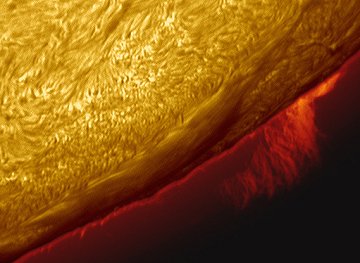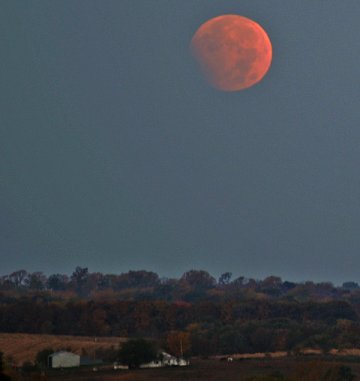 Would you like a call when the space station flies over your backyard? Sign up for SpaceWeather PHONE.
Would you like a call when the space station flies over your backyard? Sign up for SpaceWeather PHONE.
IN SEARCH OF MARS: Looking for Mars? It's right beside the Moon! Step outside tonight between 9 and 10 p.m.. You'll see Mars and the Moon rising together in the east: sky map. Mars has an orange color, so it looks like a brilliant orange star. Two weeks from now, Mars will be even brighter when it makes its closest approach to Earth for the next 13 years: full story.
DUST ALERT: There's a dust storm brewing on Mars big enough to see through backyard telescopes: image. Stay tuned for updates.
SOLAR ACTIVITY: On Oct. 16th, Larry Alvarez of Flower Mound, Texas, peered at the sun through his Coronado MaxScope 90--a safely-filtered solar telescope. "The sun looked inactive at first, but upon further inspection I found two large prominances," he says. Here's one of them:

This glowing magnetic arc photographed by Alvarez is a remnant of old sunspot 798, which in August and September was a mighty active region that sparked widespread auroras on Earth. The 'spot has since decayed, but it's still putting on a good show for those who know how to look.
LUNAR ECLIPSE: There's something strange about this full Moon, photographed yesterday by Dan Bush of Albany, Missouri. It's not round!

Part of the Moon was blacked out by Earth's shadow, or, as an astronomer would say, there was a lunar eclipse. Total lunar eclipses occur when the Moon plunges entirely into shadow. Yesterday's eclipse was merely partial; only a fraction of the Moon was shaded. Even so, it was a pleasing sight, widely observed.
more images: from XR250 at Harbour Plaza, Hung Hom, Hong Kong; from Mike Salway of Central Coast, NSW, Australia; from Daisuke Tomiyasu of Kobe, Japan; from William Biscorner of New Haven, Michigan; from Johnny Layanata of Hong Kong; from Dorothy Klockziem of New Ulm, Minnesota; from Christie Ponder of Arcola, Texas;

